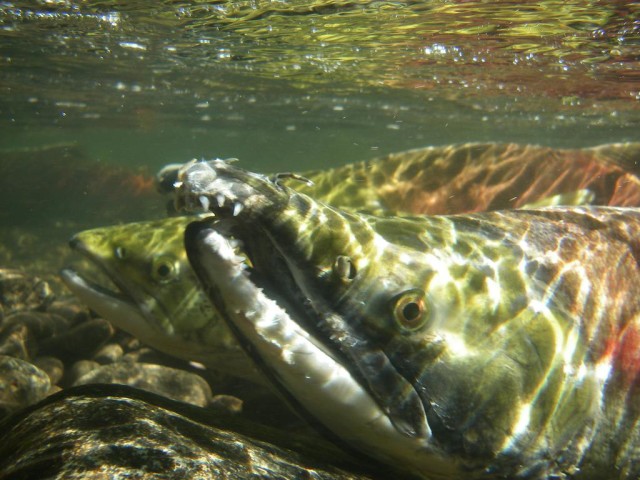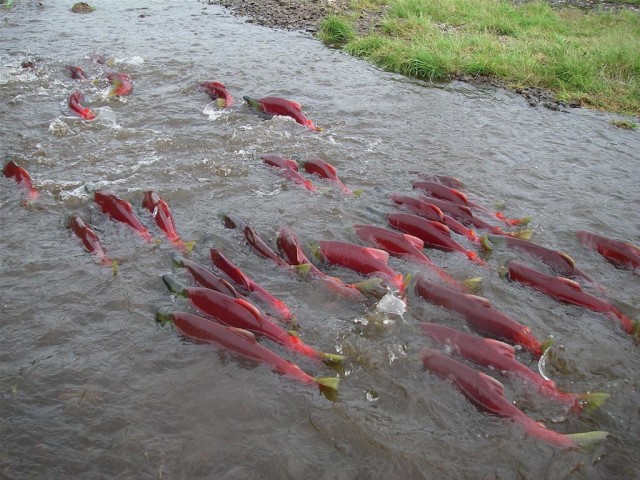Earth’s magnetic fields play a significant role in helping salmon find their way home to spawn, according to two new studies from Oregon State University.
After poring over 56 years of data, the researchers found that a magnetic map is responsible for providing sockeye salmon with their keen sense of direction which guides them home, even when they’ve been away at sea for years.
“To find their way back home across thousands of kilometers of ocean, salmon imprint on the magnetic field that exists where they first enter the sea as juveniles,” said Nathan Putman of Oregon State University who headed both studies, which were published in Current Biology. “Upon reaching maturity, they seek the coastal location with the same magnetic field.”
Imprinting is an animal’s special form of learning. While specific definitions of imprinting differ, in general this kind of learning takes place during a specific and critical period of the animal’s life, usually early in life. The effects of this learning process are long-lasting and cannot be easily altered.
A second study by the Oregon researchers found that even young chinook salmon produced at a hatchery can zero in on the direction of their ancestors’ feeding grounds with the help of Earth’s magnetic field. The researchers think salmon pass along—from generation to generation—some kind of built-in GPS system programmed to always send them home.
“In essence, the fish act as though they have a map based on the magnetic field,” said Putnam. “When the fish experience a magnetic field that is north or south of their typical ocean range, they change their swimming direction to go back.”
In previous research projects, Putman and his colleagues showed that migrating sea turtles depend on the magnetic fields to sense both their north-south and east-west positions. Up until those findings were made, scientists had doubted magnetic fields could explain how migratory animals guide themselves in the east-west direction.
For the research behind the sockeye salmon study, the Oregon group focused on the salmon that were from the Fraser River in British Columbia, Canada. Like other species of Pacific Salmon, the sockeyes leave the river and head out to the sea, but in this case there’s a bit of a glitch.
“When they attempt to return, they are confronted with a giant obstacle: Vancouver Island is blocking direct access to their river,” said Putnam. “So the fish must make a choice: do they use the northern inlet or the southern inlet in their detour?”
The Earth’s magnetic field doesn’t remain constant because something known as geomagnetic field drift causes the fields to slowly move about. Scientists say this happens due to the movement of our planet’s liquid outer core.
So with geomagnetic field drift in mind, the researchers reasoned that if the sockeyes really do follow the magnetic fields, their choice between traveling through the northern or southern inlet should gradually change back and forth over the years as the fields shifted.
Their choice in what direction to take would be due to whichever inlet provides the best match of the magnetic value of the Fraser River when they left years earlier. A comparison of records kept by fisheries since the 1950s, with the researcher’s model that predicted the shifting magnetic fields, showed the fish traveled in the expected direction.
The research behind the second, or Chinook salmon, study also revealed that the fish don’t rely on just one aspect of the magnetic field, but on a combination of two— magnetic intensity and its inclination angle.
The salmon are able to determine their position, and can be guided to their destinations, by simply picking up on the subtle differences in both the intensity and inclination characteristics. The researchers found the fish didn’t need any prior experience to gain those unique navigational skills.
























What is the pathology explaining–for the intelligent(?) layman, please–why certain species of salmon die after spawning?